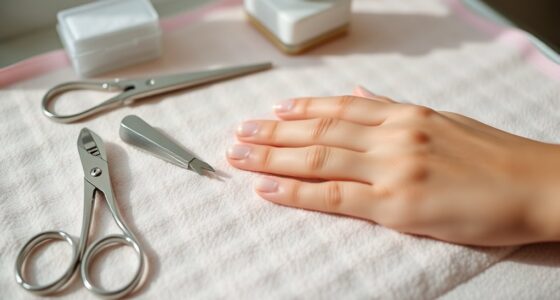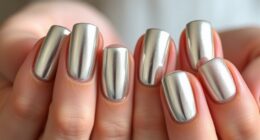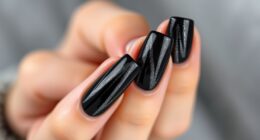To guarantee safe nail grooming for kids, choose pediatric-sized clippers with rounded tips and a non-slip grip, using gentle files for shaping. Create a calm environment, supervise closely, and keep tools clean. Establish a regular routine, praising your child to make it positive. Watch for signs of infection or nail issues, and seek professional help if needed. Exploring these tips further can help you establish a safe, stress-free nail care routine.
Key Takeaways
- Use pediatric-sized, child-safe nail clippers with rounded tips and non-slip grips for safe trimming.
- Establish a regular, calm routine in a well-lit environment, using positive reinforcement and distraction techniques.
- Keep nails trimmed to prevent scratches, avoiding cutting too close to the skin or causing injury.
- Watch for signs of infection or nail issues like discoloration, thickening, or pain, and seek professional help if needed.
- Ensure tools are clean and supervise children closely during nail care to prevent accidents and promote good hygiene.
Choosing the Right Nail Cutting Tools for Kids
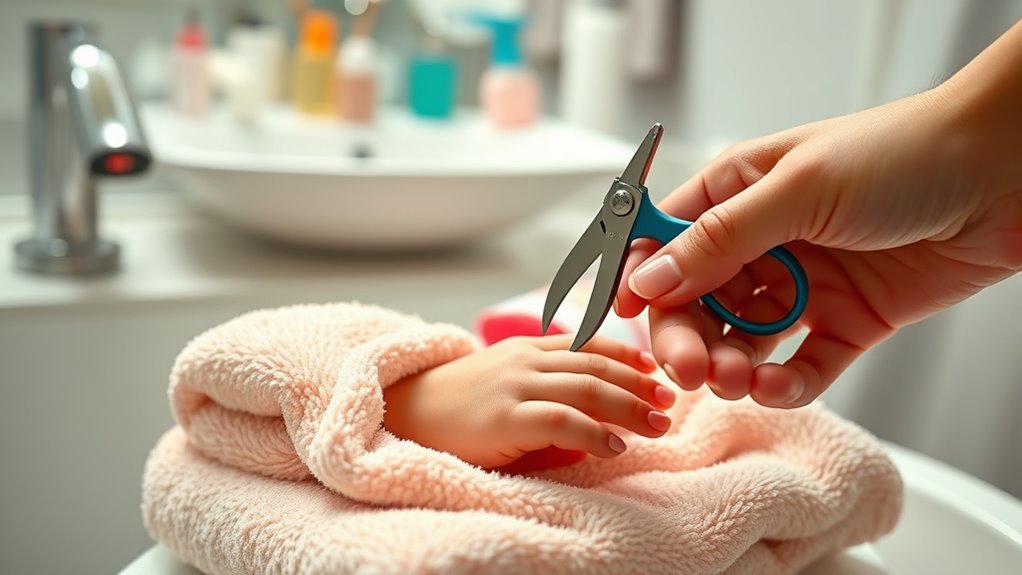
When choosing nail cutting tools for kids, it’s important to prioritize safety and ease of use. Look for nail clippers with rounded tips and a non-slip grip to prevent accidents. Small, pediatric-sized clippers are ideal, as they give you better control. If your child enjoys nail art for kids, consider gentle, child-safe nail files to shape nails smoothly without causing discomfort. While some kids love experimenting with child nail polish, ensure that any polish used is non-toxic and specifically made for children. Avoid sharp scissors or adult-sized tools that might be difficult to handle safely. The right tools make grooming easier and more enjoyable, encouraging good habits while keeping your child’s delicate nails protected. Incorporating child-safe grooming tools can further reduce the risk of injury and make the grooming routine more comfortable.
Best Practices for Trimming Children’s Nails
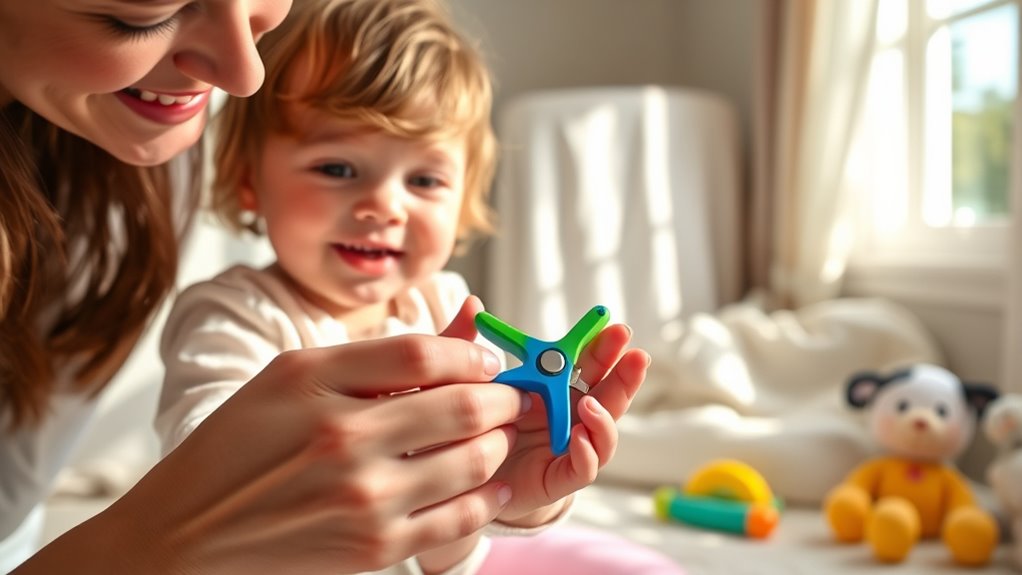
To guarantee safe and comfortable nail trimming for your child, establish a regular routine and choose a calm, well-lit environment. This helps prevent accidental nicks and makes the process less stressful. Be aware of nail trimming myths; for example, some believe trimming nails causes infections, but proper technique and hygiene are more important. When trimming, use child-safe tools and avoid cutting too close to the skin. If your child wears nail polish, ensure it’s safe and non-toxic, and avoid frequent polish use, which can cause dryness or irritation. Keep nails trimmed to prevent scratching and reduce dirt buildup. Additionally, dog names can inspire fun and unique options for your child’s pet or even a themed nickname. Patience is key—make it a positive experience by offering reassurance and praise. This approach promotes safe grooming habits and minimizes discomfort during nail care.
When and How Often to Cut Your Child’s Nails
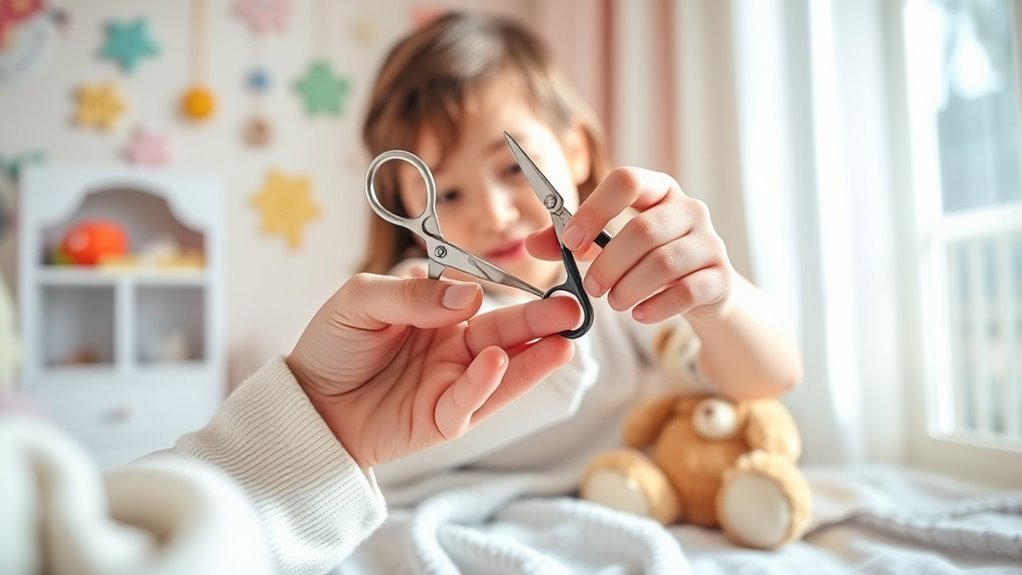
Regular nail trimming is an important part of your child’s grooming routine, but knowing the right timing helps guarantee it’s effective and stress-free. Pay attention to your child’s nail growth patterns, which can vary depending on age and season. Typically, nails grow faster during warmer months, requiring more frequent trims, while in cooler seasons, trimming may be needed less often. For infants and toddlers, trim nails weekly or every two weeks to prevent scratches. Older children might need trims every three to four weeks. Always check for signs of overgrowth or jagged edges, especially during seasonal nail care shifts. Keeping nails short and smooth minimizes dirt buildup and reduces the risk of infections. Adjust the frequency based on your child’s nail growth and seasonal changes for ideal nail health. Since nail growth rates can be influenced by environmental factors, monitoring these changes helps maintain proper grooming routines.
Tips for Making Nail Care a Positive Experience

Making nail care a positive experience starts with creating a calm and reassuring environment. Your goal is to make your child feel comfortable and confident during grooming.
Here are some tips to achieve that:
- Use gentle, encouraging words to boost their confidence and encourage independence.
- Let your child choose a safe, child-friendly nail polish if they’re interested, emphasizing nail polish safety.
- Keep the mood light and fun—play music or tell a story to distract them from any discomfort.
- Praise their cooperation to reinforce a positive attitude towards nail care.
- Incorporating positive reinforcement can help children feel more at ease during grooming routines.
Safety Precautions During Nail Grooming
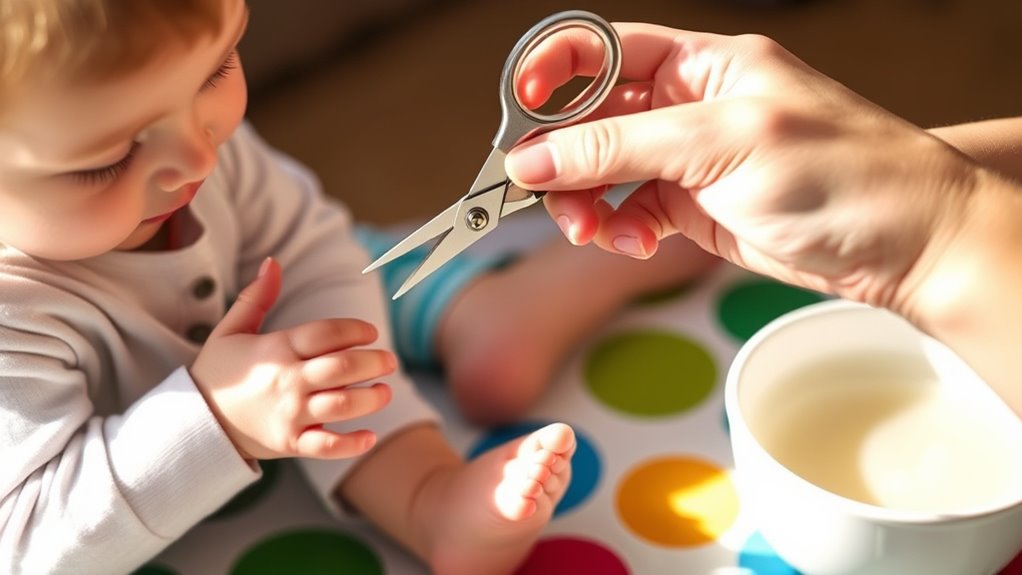
Always use child-safe tools to prevent accidental injuries during nail grooming. Keep a close eye on your child and supervise the process to make certain their safety. Taking these precautions helps make nail care both safe and stress-free for your little one. Additionally, being aware of best grooming practices can ensure a positive experience for both parent and child.
Use Child-Safe Tools
Using child-safe tools is essential to guarantee your child’s nail grooming is both safe and comfortable. Choosing the right nail tool safety measures helps prevent cuts or injuries. Here are four tips to ensure safe grooming:
- Select child-safe tools with rounded edges and non-slip grips for better control.
- Use lightweight, ergonomic nail clippers designed specifically for little fingers and toes.
- Avoid metal tools that may pinch or hurt delicate skin; opt for gentle, plastic emery boards.
- Always check that tools are clean and sanitized before use to prevent infection. Incorporating sustainable materials into grooming tools can also reduce environmental impact and promote eco-friendly practices.
Supervise During Grooming
Since young children can be curious or restless during nail grooming, it’s important to supervise them closely to prevent accidents. Keep their attention away from distracting activities, like playing or reaching for nearby objects, to avoid sudden movements. Your active parental involvement helps ensure they stay still and calm throughout the process. Use gentle commands to remind them to stay still and explain what you’re doing to ease any anxiety. Never leave your child unattended while trimming or filing nails, as even a quick movement can cause injury. By supervising closely, you control the environment, reducing risks and making nail care a safe, stress-free experience. Your presence reassures your child and promotes safe grooming habits from an early age. Additionally, AI-driven supervision tools can assist in monitoring children during grooming sessions to further enhance safety.
How to Deal With Child Nail Biting or Chewing

Child nail biting and chewing can be common habits that are tough to break, but understanding why your child does it is a good first step. This behavior may stem from stress, boredom, or oral health needs. To address it, focus on effective behavior management and supporting healthy oral habits. You can try: 1. Offering alternative activities like chewing gum or a stress ball to redirect their focus. 2. Reinforcing positive behavior with praise when they resist nail biting. 3. Keeping nails trimmed short to reduce temptation. 4. Talking to your child about how nail biting can harm their oral health and encouraging awareness. Additionally, understanding that some children may develop these habits due to electric power generation with bike generators, which can influence their energy levels and habits.
Maintaining Nail Hygiene Between Trims

Maintaining good nail hygiene between trims is essential for preventing infections and keeping your child’s nails healthy. Regular hand cleanliness helps reduce bacteria and dirt buildup that can cause skin irritation or illness. Encourage your child to wash their hands thoroughly with soap and water after playing, using the restroom, or before meals. Keep their nails clean by gently scraping under the nails with a soft nail brush or cloth during handwashing. Remind your child not to bite or pick at their nails, which can transfer germs. Using moisturizer can also prevent nails from becoming brittle or cracked, reducing the risk of dirt accumulation. By maintaining consistent nail hygiene, you help protect your child’s overall health and promote good grooming habits.
Recognizing and Addressing Nail-Related Skin Issues

Being able to recognize nail-related skin issues early can prevent infections and discomfort for your child. Watch for signs like redness, swelling, or soreness around the nails, which indicate skin irritation. Nail infections may appear as yellow or greenish spots, or pus under the nail. Here are four common issues to look out for:
- Redness or swelling around the nail bed
- Discolored or thickened nails indicating possible infection
- Skin irritation or peeling near the cuticles
- Pus or oozing from under the nail area
If you notice any of these signs, address them promptly. Keeping nails clean and trimmed helps prevent further issues. Avoid biting or picking at nails, which can worsen skin irritation and increase infection risk. Early detection guarantees your child’s comfort and health. Additionally, choosing nail shapes suited to your child’s fingers can reduce the likelihood of nail problems.
When to Seek Professional Nail Care Assistance

Knowing when to seek professional nail care help is vital to make certain your child’s nails and skin stay healthy. If you notice persistent redness, swelling, or signs of infection, it’s time for a professional consultation. Children with nail abnormalities like thickening, discoloration, or ingrown nails also need expert assessment. Similarly, if your child’s nail health assessment reveals persistent issues despite proper grooming, consulting a specialist can prevent complications. Don’t hesitate to seek help if your child experiences pain or discomfort during nail care routines. A trained professional can provide precise treatments and advice tailored to your child’s needs. Remember, early intervention can prevent more serious problems and ensure your child’s nails remain healthy and strong. Additionally, understanding the divorce process and requirements can help parents navigate legal procedures effectively.
Frequently Asked Questions
How Can I Prevent My Child From Injuring Themselves During Nail Trimming?
You can prevent your child from injuring themselves during nail trimming by following safety precautions and proper trimming techniques. Always trim nails after a bath when they’re soft, and use child-safe nail clippers. Keep your child’s hand steady and avoid cutting too close to the skin. Teach your child to stay still during trimming, and consider doing it when they’re calm. These steps help minimize the risk of injury and make the process safer.
Are There Natural or Chemical-Free Nail Products Suitable for Children?
You can find natural alternatives and chemical-free options that are perfect for your child’s delicate nails. These products avoid harsh chemicals, making them safer for young skin. Look for brands that emphasize organic ingredients and gentle formulas, ensuring your child’s nail care routine stays safe and effective. By choosing natural and chemical-free options, you protect your little one from potential irritants, giving you peace of mind during grooming.
What Signs Indicate Nail Infections or Other Nail Health Issues in Kids?
You should watch for signs monitoring that indicate nail infections or other issues in your child. Look for infection symptoms like redness, swelling, pus, or persistent pain around the nails. Discoloration or thickening can also be warning signs. If you notice any of these, it’s important to seek medical advice promptly to prevent further complications and make certain your child’s nail health stays on track.
How Do I Handle Stubborn or Resistant Children During Nail Grooming?
To handle stubborn or resistant children during nail grooming, use behavior management strategies like gentle reassurance and clear explanations. Incorporate distraction techniques such as singing, counting, or offering a favorite toy to keep their attention away from the process. Stay calm and patient, giving breaks if needed. Positive reinforcement, like praise or small rewards afterwards, encourages cooperation and makes future grooming easier.
Can Nail Care Routines Help Reduce Childhood Nail-Biting Habits?
Nail care routines can definitely help reduce childhood nail-biting habits. When you establish a consistent schedule, kids become more aware of their nails and less likely to bite out of boredom or anxiety. Keep nails trimmed and smooth, and involve your child in the process to make it fun. Using gentle, positive reinforcement encourages habit reduction, helping your child develop healthier nail habits over time.
Conclusion
Think of nail care as nurturing a tiny garden—you’re tending to delicate blooms that reflect your child’s health and happiness. With gentle tools and positive routines, you help your little one grow confident and comfortable. When you prioritize safety and kindness, you’re cultivating trust and comfort that blossom into lifelong habits. Remember, you’re the gardener guiding this small but essential part of your child’s well-being, helping their confidence flourish with each caring touch.





